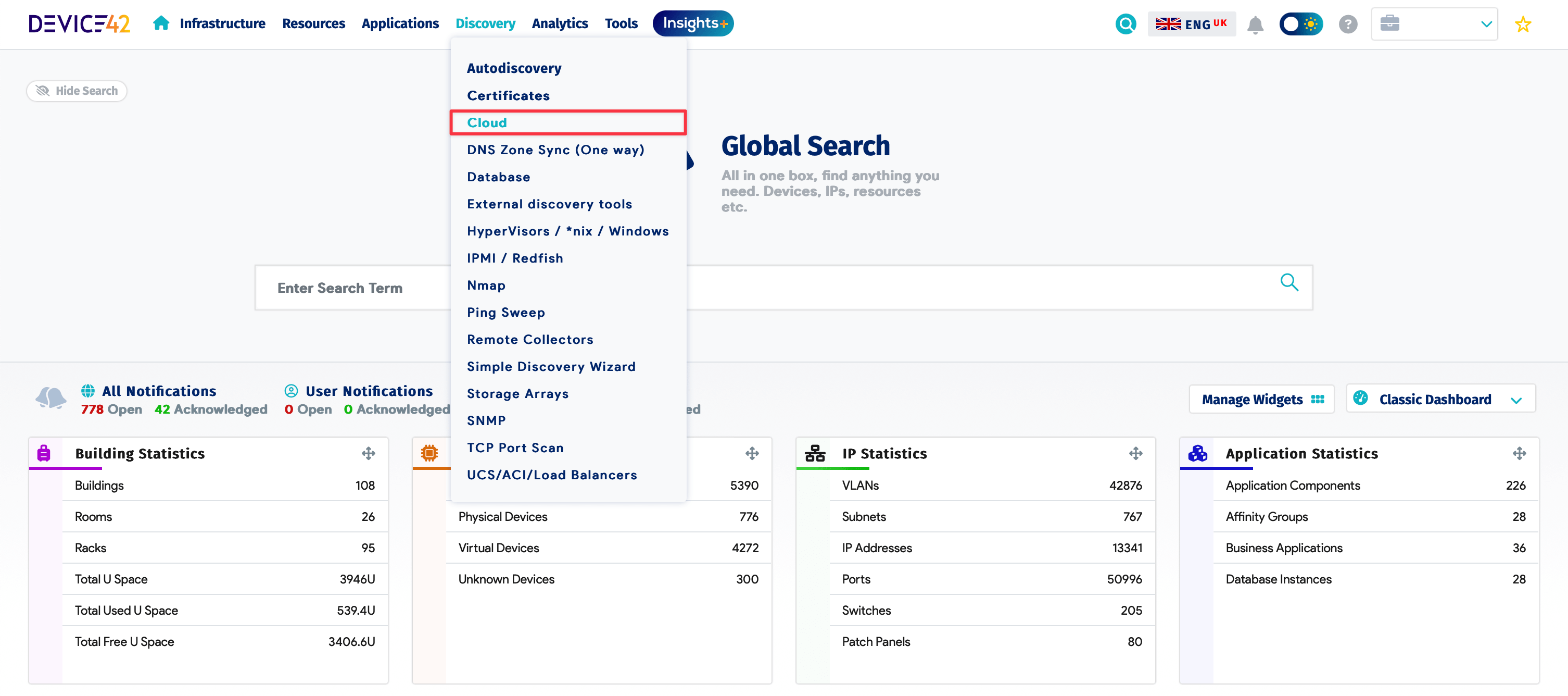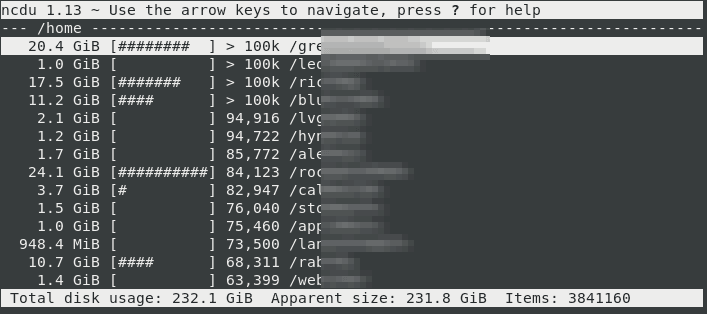What Is Device42?
Through automated tools and real-time insights, Device42 empowers IT teams to manage multi-cloud environments adeptly, enhancing strategic planning and operational resilience. By simplifying intricate processes and providing a centralized overview, it ensures organizations can align their IT strategy with business objectives, leveraging cloud technologies to their fullest potential.
Through analysis and reporting, Device42 assists in evaluating the post-migration effectiveness of cloud assets. This evaluation highlights optimization opportunities, ensuring that migrated applications perform efficiently in their new environment. By reducing complexity and enhancing accuracy in migration processes, Device42 enables organizations to achieve their cloud strategy goals more effectively.
Key Features of Device42 for Cloud Asset Management
IT Inventory and Asset Management
With Device42’s insights, organizations can optimize cloud resource utilization, ensuring efficient deployment and management of workloads. It helps avoid vendor lock-in by supporting flexible operations across different providers. Moreover, the tool aids in maintaining compliance and security through consistent monitoring and tracking of all cloud assets.
Device42 offers capabilities that streamline cloud asset management, ensuring organizations maintain visibility over complex IT environments. Its features facilitate asset management, application dependency mapping, and hybrid cloud performance monitoring. These functionalities allow organizations to optimize their IT operations, resulting in increased efficiency and reduced operational risks.
CMDB
This feature helps reduce shadow IT, optimize cloud costs, and ensure organizations meet compliance requirements by maintaining visibility over all cloud-based resources.
Device42’s configuration management database (CMDB) is central to managing complex IT environments. The CMDB integrates and stores data related to all configuration items in the IT landscape, ensuring organizations have a single source of truth. By categorizing and documenting these elements, Device42 aids in understanding and managing the IT environment’s complexity, providing insights for change management and incident resolution.
Data Center Infrastructure Management (DCIM)
Device42 is a software solution for IT asset management and data center infrastructure management. It helps organizations keep track of their IT resources, both on-premise and in the cloud. With Device42, users can maintain an accurate inventory, manage assets, and gain insights into their IT infrastructure. This tool caters to a range of industries, ensuring operations, higher resource utilization, and a clear overview of an organization’s asset landscape.
This capability is invaluable for troubleshooting and impact analysis as it connects dependencies across systems, applications, and services. With accurate, up-to-date configuration data, organizations can predict the impacts of proposed changes, assess risk, and manage incidents more effectively. Device42’s CMDB increases visibility and control, reducing the likelihood of downtime and enabling rapid resolution of IT issues.
Application Dependency Mapping
Device42 simplifies asset tracking with its automated discovery and dependency mapping features. These capabilities enable organizations to understand the interdependencies among various components and make informed decisions. By maintaining a centralized repository of IT assets, Device42 serves as a tool for operations teams aiming to optimize resource deployment and mitigate risks.
Device42 aids organizations when undertaking cloud migrations by providing tools to track and optimize the migration process. It maps application dependencies and identifies potential risks, helping in planning and executing cloud migrations with minimal disruption. This capability ensures a smoother transition by avoiding pitfalls such as unexpected downtime or loss of data integrity, common during migrations.
Use Cases of Device42 in Cloud Asset Management
Multi-Cloud Environment Management
The ability to monitor the entire hybrid setup from a single interface streamlines operations and enhances cost management, ensuring that expenditures align with business objectives. Device42’s tools halt unnecessary spending and highlight resource strains, allowing for proactive management and strategic adjustments to optimize operational efficiency.
This feature plays a role in change management by revealing potential impacts across the IT environment, thereby supporting risk assessment and decision-making. With insights into how applications interconnect, Device42 ensures organizations can anticipate challenges, develop strategic responses, and maintain high service levels even in complex environments.
Cloud Migration Tracking and Optimization
By using integrated monitoring and analysis tools, Device42 delivers data that IT teams need to improve capacity planning and anticipate future infrastructure needs. Additionally, DCIM contributes to reducing operating expenses by identifying inefficiencies and enabling proactive maintenance strategies. These capabilities ensure smoother operations, reducing the risk of outages and enhancing service delivery.
Device42 offers application dependency mapping (ADM) capabilities, crucial for understanding the relationships between applications, servers, and infrastructure components. ADM automatically discovers and maps these dependencies, providing a view of application workflows and interactions. This visualization allows IT teams to manage resources better, optimize performance, and minimize disruption during updates or migrations.
Monitoring Cost and Performance in Hybrid Cloud Setups
Data center infrastructure management (DCIM) in Device42 focuses on optimizing the management of physical and virtual data center assets. This feature helps IT teams monitor resources such as power consumption, space usage, and cooling efficiency, providing real-time insights for operational optimization. DCIM helps organizations maximize their existing infrastructure’s return on investment by efficiently managing data center resources.
Device42 provides a view of IT assets through its inventory and asset management features. It facilitates real-time tracking of hardware and software assets, giving IT teams precise information about the inventory scattered across on-premises and cloud environments. This feature ensures that organizations have the most current understanding of their asset landscape, leading to more efficient resource planning and minimizing redundancy.
Example of Device42 for Cloud Asset Management: Cloud Platforms Autodiscovery

How it Works
In hybrid cloud setups, managing costs and performance can be challenging due to their complexity. Device42 addresses this by providing monitoring tools that track usage patterns and performance metrics across both private and public clouds. These insights enable organizations to make informed decisions about resource allocation, identify cost-saving opportunities, and ensure optimal performance levels throughout the hybrid environment.
By Gilad David Maayan
Cloud autodiscovery jobs in Device42 identify cloud assets by scanning specific cloud environments and adding these assets to the organization’s central inventory. These discovered assets, whether virtual machines or databases, are treated as standard IT resources within the platform, meaning users can define their application components, assign service levels, and categorize them for better organization.
How to Configure Cloud Autodiscovery
- Access the cloud discovery menu: Navigate to Discovery > Cloud from the Device42 dashboard. This will take you to the cloud discovery list page where you can view existing discovery jobs or create new ones.
- Create a new autodiscovery job:
- Click the + Add Cloud Autodiscovery button.
- Select the cloud type you want to scan (AWS, Azure, Google Cloud, etc.).
- Configure the job by entering the required credentials and settings for the selected cloud platform.
- Schedule the job to run immediately or at a later time.
- View discovered cloud instances: After a discovery job runs, navigate to Resources > All Devices and use the Virtual filter to view cloud-based virtual devices. Each discovered instance will include detailed information, such as service level and resource category, helping you manage cloud assets efficiently.
Source: Device42
Conclusion
Efficient asset management aids in compliance and auditing efforts by maintaining detailed records and histories of each asset. This feature not only enables organizations to keep track of their physical and virtual assets but also helps in financial management, allowing for better budgeting and procurement processes. With Device42, organizations can streamline IT operations, reduce manual interventions, and improve overall operational efficiency.
Device42 proves invaluable for managing assets across multi-cloud environments. It offers a unified platform to track and manage resources distributed across different cloud providers, ensuring an organized overview of cloud assets. This feature alleviates the complexity of multi-cloud management by offering visibility, reducing the siloing of information, and enabling resource coordination across platforms.
Device42’s cloud platforms autodiscovery feature allows organizations to automatically detect and manage cloud resources across various platforms, such as AWS, Azure, Google Cloud, and more. This functionality helps maintain an up-to-date inventory of cloud instances (referred to as “virtual devices”), databases, and storage, giving IT teams the same level of visibility and control over cloud assets as they have with on-premise devices.






